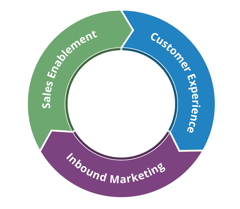Have you ever completed a marketing campaign and realized that, while it may have been a success, it will be difficult to replicate because there wasn't a defined strategy or process behind it? If so, you're not alone.
Comprehensive marketing campaigns can have 10 to 30+ individual content-related tactics that need to be executed to make them integrated and cohesive. These content-driven tactics are usually executed in tandem to ensure all the pieces fit together to build a campaign that will drive traffic, leads, and new customers to your organization.
Most importantly, it is critical to ensure you are not only building a repeatable content strategy but that you have something documented and understood by all team members. When the campaign is over and it's time to analyze the results, a gaping hole often becomes evident: There was no documented strategy to drive the tactics. This scenario helps explain the fact that only 37% of B2B marketers say they have a documented content marketing strategy. Without a plan, we see that while marketers have the best intentions, sometimes these operational pieces get missed. This tends to leave a gap in your department that could become detrimental as your team changes.
A content marketing strategy should address the crucial “what are we doing?” and “why are we doing it?” questions. Strategy provides the rationale behind your campaign and the pieces that will work together to make your campaign a success. Tactics also play a pivotal role, but they come second because they address the “how are we going to do it?” question.
Think of your content marketing as a way to provide direction and keep a campaign on track. Content can take many forms, including email, website, landing pages, social media, blogs, articles, video, whitepapers, and much more. Without a mapped-out strategy, it can become a tangled mess, almost impossible to unravel.
Here are eight steps to ensure you're creating the most robust content strategy to set up your team for success:
1. Set goals with a content mission statement. Consider starting with: “We must provide X type of content to fulfill Y need or want and/or evoke (this emotion) in our target customer so they do Z (visit our website, purchase this product or service, or take another specific action).” Now is a good time to discuss the overall tone of your content, though it may change as you drill down and select your preferred modes of communication.
2. Refine the profile of your target customer. Also known as your buyer persona, it is vital to define the demographics of your target customer and the psychographics that will highlight key points about your customer's lifestyle, opinions, and values. This will help you understand the types of content that will engage these prospects.
3. Conduct a content audit. Publishing weekly articles on your blog may be the cornerstone of your content marketing strategy, but now is the time to see how those blogs are performing and how your audience responds to them. Review your content efforts critically, focusing on how you fully capitalize on your content, especially on social and through segmented and optimized email marketing.
4. Brainstorm content ideas. Content ideas are everywhere, and content truly is limitless. You can use one piece of content to create five to 10 additional unique pieces. Think about your content and how you can leverage it to create new forms of content. Focus on what your business does best and how it differs from the competition. Many good content ideas should flow from that process.
5. Identify the types of content that will best serve your needs. You cannot, and probably should not, invest time and money in all forms of content. But this is where formulating a content marketing strategy will become invaluable, steering you to choose between the types of content your target customers want and need most. The options may include lists and how-to articles (favorites among many personas), case studies, interviews, infographics, videos, podcasts, and emails.
6. Select a content analytics system. As marketing supports sales, your content marketing strategy should support your business goals. To ensure it does, carefully select an analytics system or partner with a company that can help. The Content Marketing Institute offers excellent advice: “Don’t measure simply for having some numbers to present to upper management. If you aren’t certain what you should measure, ask yourself these two questions:
1. Do these metrics support my key goals?
2. Can I take action on these metrics?"
How you measure your content is critical because it’s how you’ll see success and areas for opportunity.
7. Share your content marketing strategy with stakeholders. Everyone who has a vested interest in your strategy's success ought to be apprised of your progress with content. This will foster a sense of involvement and encourage feedback. Sharing your content with stakeholders will give them an opportunity to get a closer look at what the marketing team is doing to drive value while also getting their personal brand in front of your target audience.
8. Publish and manage your content efficiently. All your content should be placed on an editorial calendar so that you always know what lies ahead and can adjust your plan accordingly. It’s important to remember this step so that your content doesn’t reach the same audience too frequently or not frequently enough.
Developing a content strategy doesn’t happen overnight. It's not a one-time strategy session. Your content mapping strategy is at the helm of everything you do as a marketer, from small campaigns to large, comprehensive online and offline campaigns. Remember to continue revising your strategy and sharing it with your team so it is documented, repeatable, and understood by all members of your organization.
If you're looking to discuss your content marketing strategy as part of your overall integrated and digital plan, we invite you to schedule a complimentary 30-minute inbound marketing consultation with our team.



__Square.png?width=250&height=250&name=Marketing_Hub_(1)__Square.png)




.png?width=250&name=diamond-badge-color%20(1).png)
